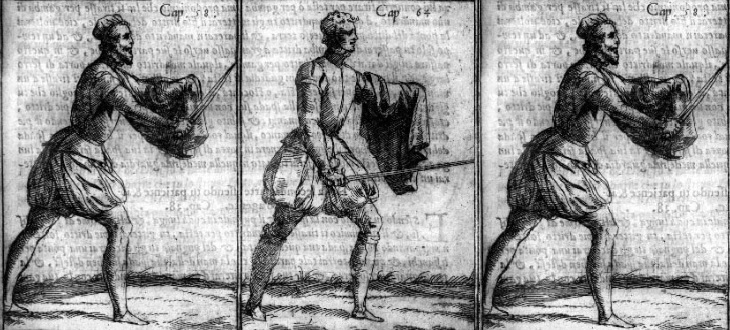Today we’re going to teach you how to land more punches using a time-honoured fight strategy that applies to any martial art. The best techniques are universal, meaning they’ll work equally well in the cage, ring, or piste, so we’ve combined MMA film study and fencing philosophy to highlight a boxing technique we like to call cloak and dagger fighting.
CASE STUDY: Jon Jones vs. Ovince St. Preux at UFC 197
It’s quite possible that nobody has ever needed to know how to land more punches in a hurry than MMA light-heavyweight Ovince St. Preux.
Called upon to fight Jon Jones – the greatest light heavyweight in MMA history – with only 22 days notice, OSP knew his only chance was to land his big power cross early and often.
Jones’ trainer Greg Jackson knew it too. While the MMA community reeled about Daniel Cormier’s last-minute cancellation and Jones’ probation issues, Jackson calmly assessed their new opponent on The MMA Hour. It was still early – Jackson said he’d “get into the micros” of his strategic analysis later that day – but their team had already honed in on the primary threat.
“OSP’s got that straight cross, and that thing, it’ll knock anything down if it hits it the right way,” he told Ariel Helwani.
Fast forward to UFC 197:
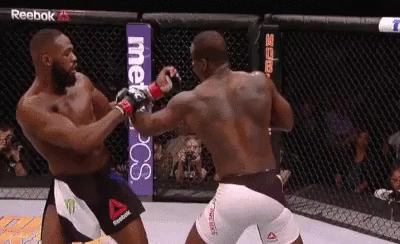
Granted, OSP didn’t win that fight, but his use of cloak and dagger fighting concepts got him pretty damn close.
Okay, what the @#$% is cloak and dagger fighting?
“Cloak and dagger” is a phrase that I use to describe a specific system of power-punch set-ups that involve the off-hand. This includes probing punches, glove control, and feints, some of which you’ll learn today.
Cloak and dagger was an actual fencing style. As its name suggests, it involved wielding a dagger in one hand a cloak in the other. Fencing master Achille Marozzo wrote about this method in his manual Opera Nova, highlighting the cloak’s use for obstructing the opponent’s vision, masking the movement of the dagger, and parrying. Simply put, the cloak distracts while the dagger stabs
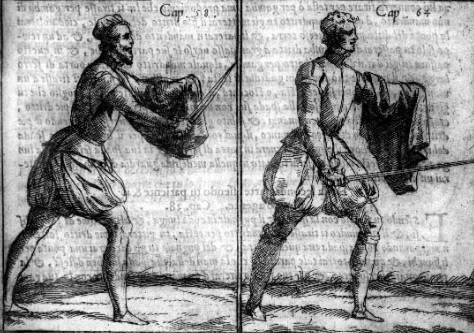
In a boxing context, this strategy involves setting up power shots with off-hand distractions. Lead-hand set-ups for rear-handed power punches are more common and beginner-friendly, but “off-hand” (as in non-power punching hand) is a more accurate term, because advanced fighters do occasionally use rear-hand set-ups for lead-handed power. Today’s case study will teach you how to land more power punches by educating your off-hand set-ups, developing your “cloak” so your “dagger” can strike more often.
Educating the Off-Hand: 3 Ways to Use the “Cloak”
Though his boxing style isn’t particularly pretty, OSP does have a smart off-hand set-up game. He uses his lead-hand “cloak” in ways that enhance defense and allow him to land big power punches.
As you can see with a quick look at his fight with Pat Cummins, he spends a lot of time pawing with the lead hand:
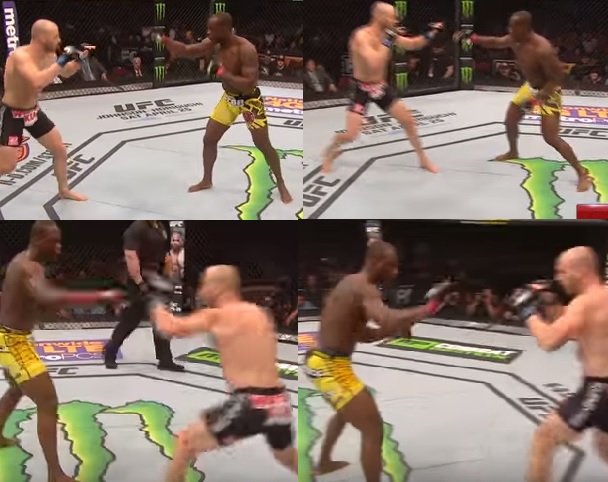
Though casual fans might lose patience in fights with lots of pawing, it’s only because they don’t understand the complexity of the hand-fighting game. In reality, pawing set-ups like these are one of the most interesting things that can happen between attacks.
Extending the lead hand and pawing at the opponent’s glove is one of the most common ways southpaws “use the cloak” against orthodox fighters, and vice versa. Each fighter will paw at the other’s jab until somebody gets their timing right and shoots a lead cross. You can watch Andre Ward’s fight against Chad Dawson for a master-class on this topic in reverse.
Beyond southpaw vs. orthodox match-ups, pawing is an energy-efficient option for anybody who wants to learn how to land more punches. High-level fighters in MMA, boxing, and Muay Thai use this technique to:
- manage distance
- trigger favourable reactions from the opponent to create openings
- shut down opponents’ attack options
- set up power shots
- set timing traps (“lulling the opponent to sleep”)
Let’s review OSP use of off-hand pawing to set up big power punches.
1. Pawing with the off-hand as a feint
Pawing with the lead acts as a hand feint, creating offensive opportunities by getting the opponent to react to the wrong punch. Moreover, the threat of the lead hand can be combined with dynamic rear hand positions to really scramble the opponent’s defensive radar.
In Frame 2, we see just that: OSP dangles his left hand low to suggest an uppercut is coming, in contrast to the left cross he threatens in Frame 1.
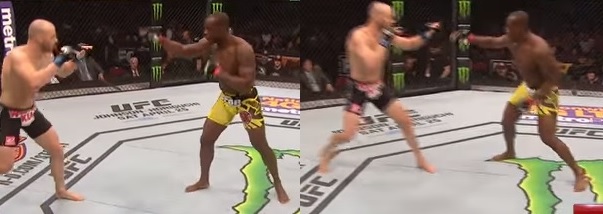
From Cummins’ perspective, Frame 2 looks like a jab-uppercut combination coming his way, and his false reaction creates offensive opportunities for OSP.
If you want to learn how to land more punches, this is a good a place as any to start. Get your opponent reacting to a punch that isn’t coming, thereby forcing them out of position and creating an opening for the kill-shot.
2. Pawing with the off-hand as defense
Sticking your hand out in “no man’s land” – the space between you and your opponent – creates some obvious problem for your opponent’s offense. Not only is it a threat, but it’s also an obstacle that their punches have to get around.
When Andre Ward appeared on In This Corner with James Smith to demonstrate some of his secrets to success, he said that a jab can “set up a lot for you, and also get you out of a lot of trouble.” In particular, Ward stressed the lead hand’s utility for distance control and block-and-parry defense.
In Frame 3, you can see Ward occupying “no man’s land” with his lead hand to demonstrate:

Ward’s lead acts as hand feint, measuring stick, and defensive deterrent all at once. From Smith’s perspective, he sees a hand obstructing his path to the target, which can be very discouraging when he wants to initiate offense. He now has to punch either around or through the extended hand, which gives Ward plenty of opportunities to parry, block, or otherwise disrupt the punch. Here we see OSP doing just that:
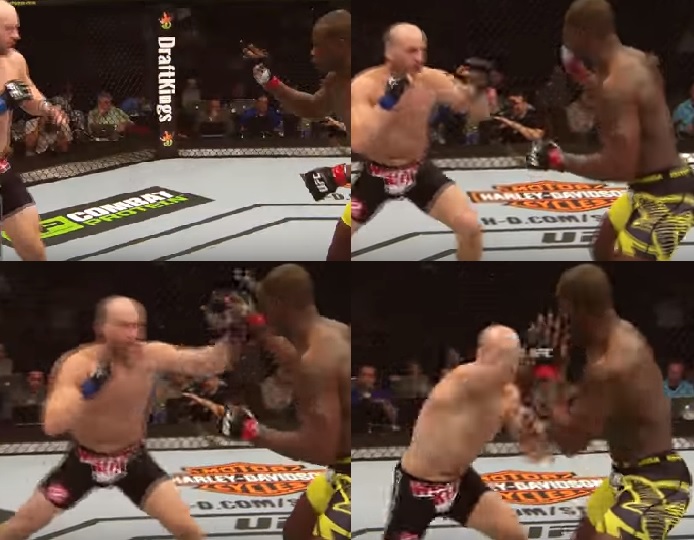
Let’s go frame-by-frame:
- OSP paws his lead hand into “no man’s land.”
- Cummins inches closer, then initiates the hand fight by extending his left glove to meet OSP’s lead.
- Cummins jab gets “caught in traffic.” OSP has been measuring the distance and has no trouble picking off the punch with his extended lead.
- Having gained control of Cummins’ jab, OSP easily reads the cross coming. He takes a simple step back to evade the punch.
Jumping back to Andre Ward’s lesson, we see another example of using the “cloak” for defense, in a way he refers to as a “prevent defense.” Ward recommends using the forearm as a sweeping parry from a low hand position. You can see it in action here:

OSP uses a similar “cloak parry,” denying Cummins’ straight-punching advance by brushing his forearm through that punch lane:
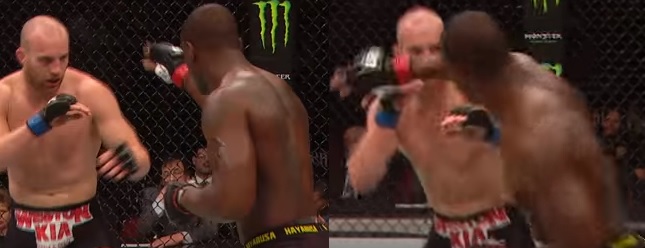
3. Pawing with the off-hand to land power punches
You’re here to learn how to land more punches, so here’s proof of concept for the “cloak and dagger” strategy.
Before he got the call for UFC 197, OSP had already had plenty of success with cloak and dagger fighting. Watch him pawing with the off-hand to set up his power left against Cummins:

This happens fast, so lets walk through each frame:
- OSP’s right hand paws in the classic southpaw control position. Notice that OSP is holding his lead hand higher than Cummins’, as he is in all four frames of the first image used to highlight his pawing style. This elevated hand position makes it easier to counter over Cummins’ jab with his own, as gravity helps him bat the hand down with a parry.
- The threat of OSP’s “cloak” causes Cummins to reach with his left hand. Like we mentioned in our point on feints, he’s committing to a punch that isn’t coming.
- OSP takes advantage of Cummins’ poor reaction and launches his left cross.
By now you know that OSP lost a unanimous decision to Jon Jones at UFC 197, but his cloak and dagger strategy nearly helped him pulled off the impossible:

This GIF encapsulates today’s lesson on cloak and dagger fighting, though OSP’s punch hits more like a pole-axe. Though he didn’t get the knockout, OSP landed the shot because of what his “cloak” hand did. We see it operating in full effect here, cloaking the true threat and winning the ‘hand fight’ to move Jones’ defending left glove out of the way.
Wrapping Up
Cloak and dagger fighting is a complex system that is beyond the scope of a single article, but I hope these boxing-in-MMA case studies help you understand a few of the off-hand set-up options available to you. I encourage you to share this with any training partners who may be struggling to learn how to land more punches in sparring and competition.
Remember to keep on the look out for learning opportunities – they’re everywhere! Don’t limit yourself to a specific fighter, or even a specific sport. Throw yourself into film study with an open mind, and it will pay off.
If you have any questions or film study requests, join the discussion on Facebook.
